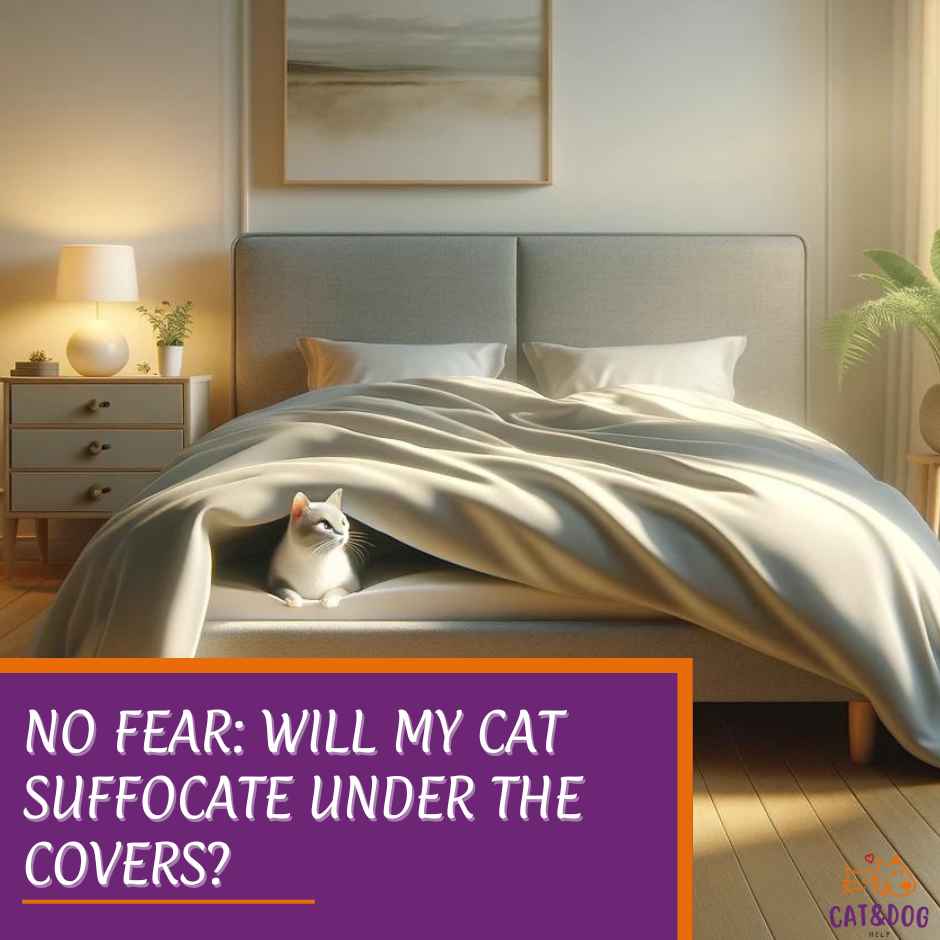Have you ever found your feline companion snuggled up beneath the covers and worried if they have enough air to breathe?
It’s a common concern for many pet parents, especially when greeted by the adorable sight of a cat-shaped lump under the blanket.
Rest assured, the curiosity of whether your cat can breathe comfortably under the covers leads to some vet-approved insights and practical advice on cat sleep.

Understanding your cat’s behaviors and preferences is essential to ensure their comfort and safety. (1)
Cats naturally seek warm, safe, and cozy spots to rest, and the underneath of your covers often fits the bill perfectly. While they do enjoy these hideaways, their instincts for self-preservation take precedence.
An average healthy cat has reflexes that will prompt them to move if their oxygen supply is compromised, easing most worries about suffocation.
However, it is important to be aware of the potential for lack of oxygen and to monitor your cat’s behavior while under the covers to ensure their safety.
Key Takeaways
- Cats have a strong instinct to seek safe, enclosed spaces for sleep, including under the covers.
- A healthy cat’s self-preservation instinct will typically prevent suffocation risks.
- Ensuring your cat’s comfort and safety strengthens the bond between pet and owner.
Understanding, Will My Cat Suffocate Under the Covers?

This urge traces back to their need for safety and warmth—two checkboxes that hiding under blankets undoubtedly ticks.
In the wild, a concealed spot can mean the difference between life and a threat, so it’s no surprise that your pampered pet still follows this instinct to find a secure place to sleep. (2)
Most cats have a penchant for finding snuggly spots, which helps them feel secure. You’ve probably seen your furball squeezing into boxes or curling up in a laundry basket.
It’s all part of their self-preservation instincts kicking in even in the safety of your home.
Assessing the Risks: Can Cats Suffocate?
Now, you might wonder if this adorable behavior has a dark side. Can your little buddy suffocate under the covers? Well, the consensus among vets is reassuring.
Cats are pretty good at looking after themselves.
Thanks to their sharp self-preservation instincts, they’re unlikely to stay somewhere they can’t breathe. They typically find pockets of air, and they’ll bolt out if it gets uncomfortable.
When it comes to picking out bedding, however, opting for breathable materials can add an extra layer of safety. (3)
Steer clear of heavy, non-breathable fabrics and choose blankets that help your feline friend stay just the right amount of toasty without compromising on airflow.
In short, while suffocation is an understandable concern, your cat’s instincts combined with the right blanket choice keep the risks at bay.
Just keep an eye on them as they explore new hiding spots, and you’ll both sleep soundly.
Deepening Understanding of Cat Behavior
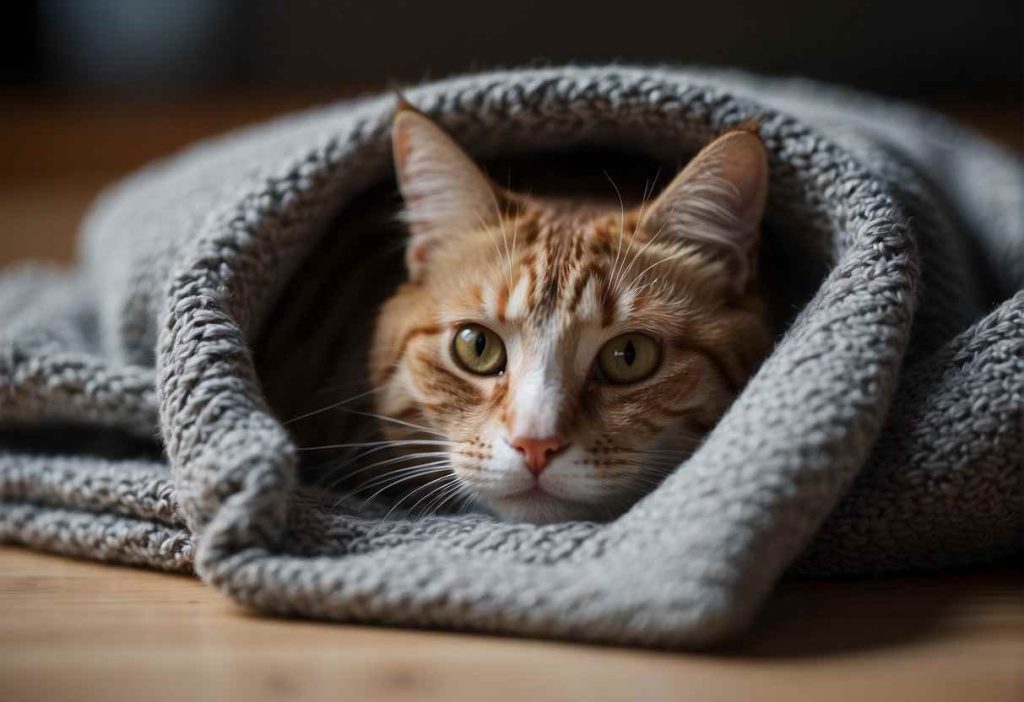
Cats crave comfort and safety, and beneath the covers, they find a warm haven that mimics the secure dens of their wild ancestors. But don’t be fooled; this behavior isn’t just about staying toasty.
- Warmth: A cat’s body temperature runs between 100.5 °F and 102.5 °F, so they often seek out cozy spots.
- Hunting Instincts: Undercovers, cats can indulge their instinct to hide and pounce, reminiscent of concealed hunters lying in wait for prey.
Now, you might think, “Is it safe for them down there?” Cats are typically good judges of their need for fresh air, so they usually won’t stay under if it’s uncomfortable. However, it’s always good to double-check.
Interpreting Your Cat’s Body Language
Deciphering your cat’s signals is like learning a secret language that tells you whether they’re in bliss or asking for an escape route. Here’s a quick guide to cat-speak:
- A relaxed posture, gentle purring, or “kneading” the blanket signals contentment.
- Signs of stress might include frantic meowing, constant movement, or sharp, sudden efforts to emerge from under the covers. (4)
Remember, while it’s adorable to see your feline friend burrowed in a blanket burrito, it’s important to ensure they can always breathe freely and have an easy way out.
Keep an eye on them, and you’ll both enjoy the cuddle sessions worry-free!
Vet-Approved Facts About Cats and Covered Sleeping
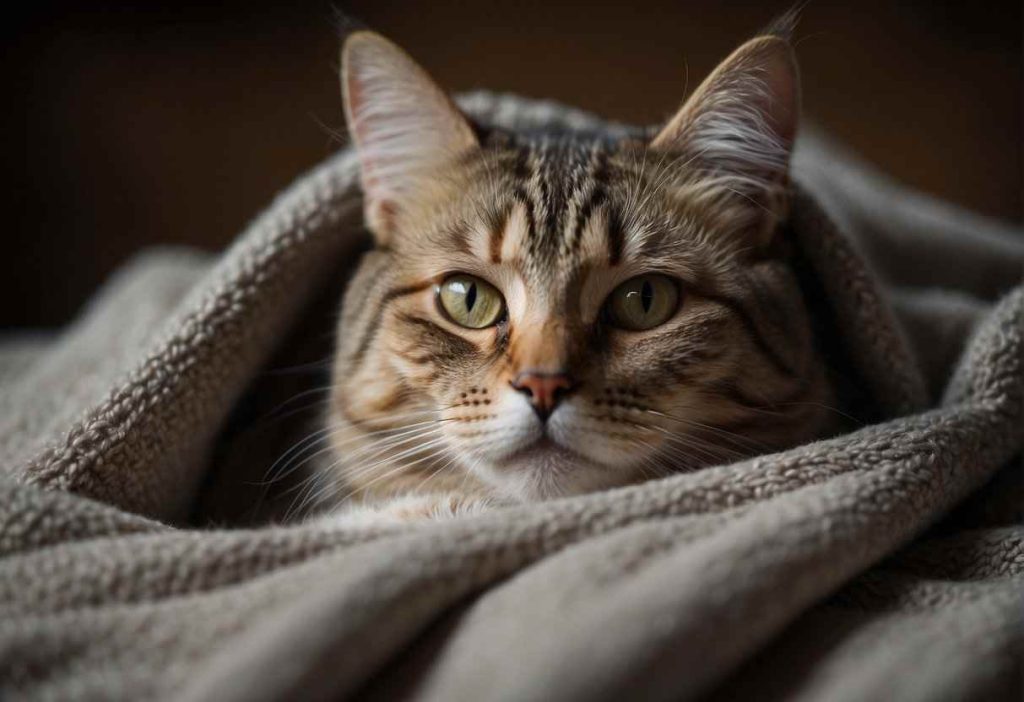
Breathe Easy: Cats are generally good at managing their breathing space and typically won’t cover their heads completely, allowing them to breathe just fine. But keep an eye out!
Very young kittens, older cats, or those with respiratory problems may not be as adept at navigating covered terrains.
- Vet Quotes: “As long as the cat can move freely under the blanket, the risk of suffocation is very low,” advises Dr. Cozy Paws, a feline respiratory specialist.
Temperature Check: Remember, a cat’s body temperature runs warmer than ours—between 100.5 °F and 102.5 °F. They’re like little furnaces on paws!
Airflow Awareness:
- Cats prefer non-restrictive spaces for their undercover escapades.
- Make sure your blanket fort allows airflow—a tight swaddle is a no-go.
Cozy But Cautious:
- Most cats will naturally exit a too-warm or uncomfortable situation.
- It’s okay to monitor their under-the-blanket playtime.
It’s All About Choice: Cats love having the option to snuggle under covers, especially on chilly days, or for a sense of security.
Give them the freedom to choose their comfort level, and they’ll be purring in dreamland safely.
There you have it! You can rest assured that, in most cases, if your cat chooses to burrow under the covers, they’re doing what feels right for them.
Keep watch over those with known respiratory issues, but otherwise, enjoy the sight of your feline friend embracing their blanket burrito lifestyle!
Strategies for Strengthening Bonds
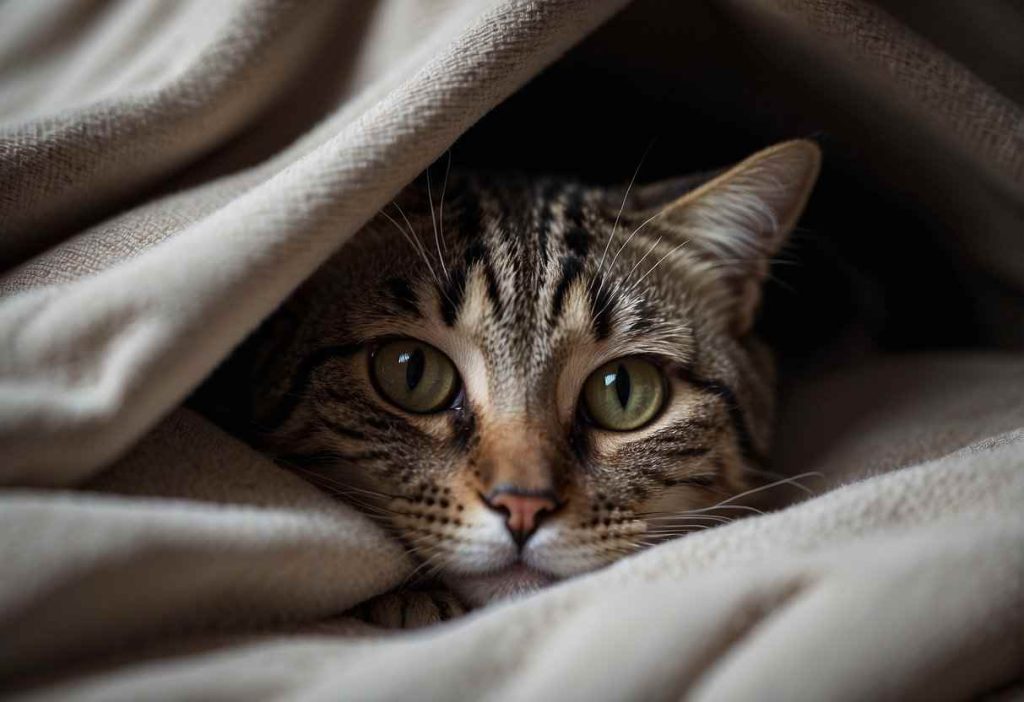
Here’s the lowdown. Do choose breathable fabrics for your pet’s bedding to ensure they have plenty of fresh air, even under the covers.
Cats value their independence, so don’t force cuddle time. Let them come to you.
Offering a cozy blanket made from breathable materials can be an inviting way for your cat to seek comfort and security on their terms, especially if they suffer from allergies or asthma.
- Do initiate play sessions to stimulate their instincts.
- Don’t disrupt their sleep; cats cherish their naptime.
- Do recognize their space—some like to snuggle, while others don’t.
Remember, respecting their autonomy keeps stress levels down and happiness up.
Enhancing Your Relationship Through Play and Comfort
Ready to be the best cat companion? Start by ensuring your cat has a snuggly retreat lined with soft, breathable blankets.
Not only does this provide a safe space, but it’s perfect for those hide-and-seek moments they adore. Speaking of play, it’s like the secret sauce to bonding. (5)
Engage in chasing games or use toys to mimic prey—it’s like catnip for your bond!
- Create a dedicated play zone with a variety of toys.
- Include a comfortable sleeping area with breathable fabric.
By understanding and catering to your cat’s needs, you’re set to strengthen that special connection. So, stock up on those airy, breathable fabrics, set aside time for games, and watch your bond grow!
Practical Tips for Cat Owners
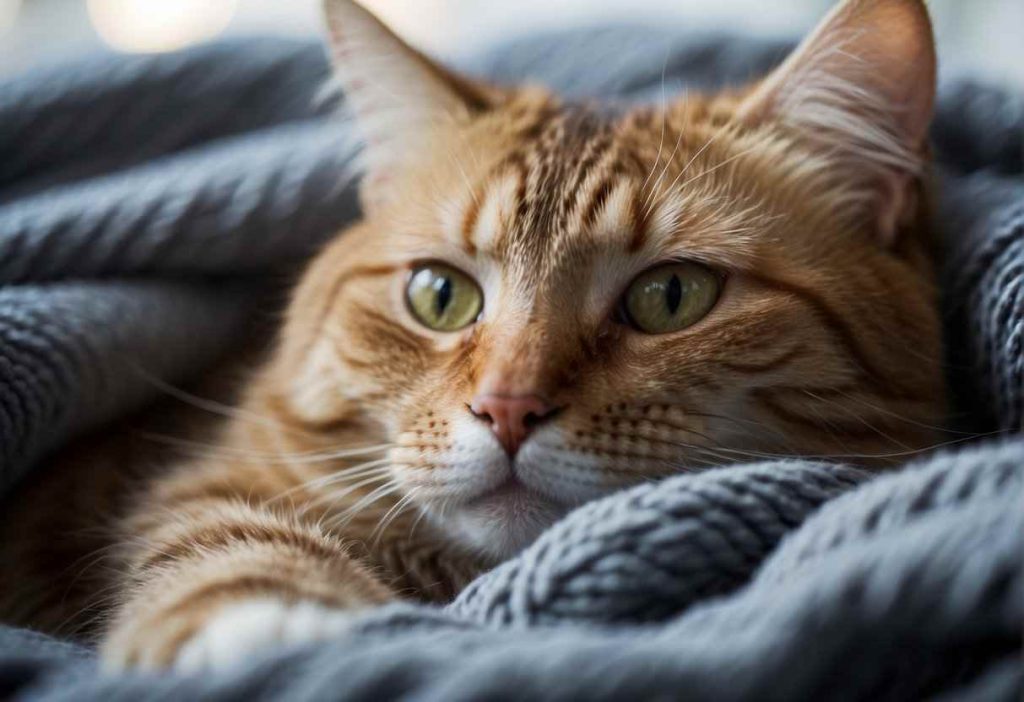
Signs like restlessness or rapid breathing can be a giveaway that your furry overlord isn’t as comfortable as they appear.
Look out for other signs of illness, such as lethargy and lack of appetite, and trust your gut—if something seems off, it might very well be. (6)
Creating a Safe Sleeping Environment
Remember, creating a cat-friendly space is like interior design for their well-being! Here’s how you can nail the feline sleeping sanctuary:
- Choose Breathable Materials: Opt for lightweight, breathable fabrics for bedding to prevent overheating.
- Accessibility Is Key: Ensure they have an easy escape route to avoid feeling trapped.
- Placement, Placement, Placement: Don’t hide the bed in a corner. Somewhere more open can help them feel less enclosed.
- Let Them Explore: Give them time to get used to new sleeping spots. Cats are curious beings but also creatures of comfort.
By keeping these pointers in mind, your cat’s napping nirvana is just a purr away.
And if you ever feel uncertain, remember, a quick check-in never hurt—just a gentle peek to make sure they’re the picture of peace beneath those covers.
Humor and Relatability in Cat Care
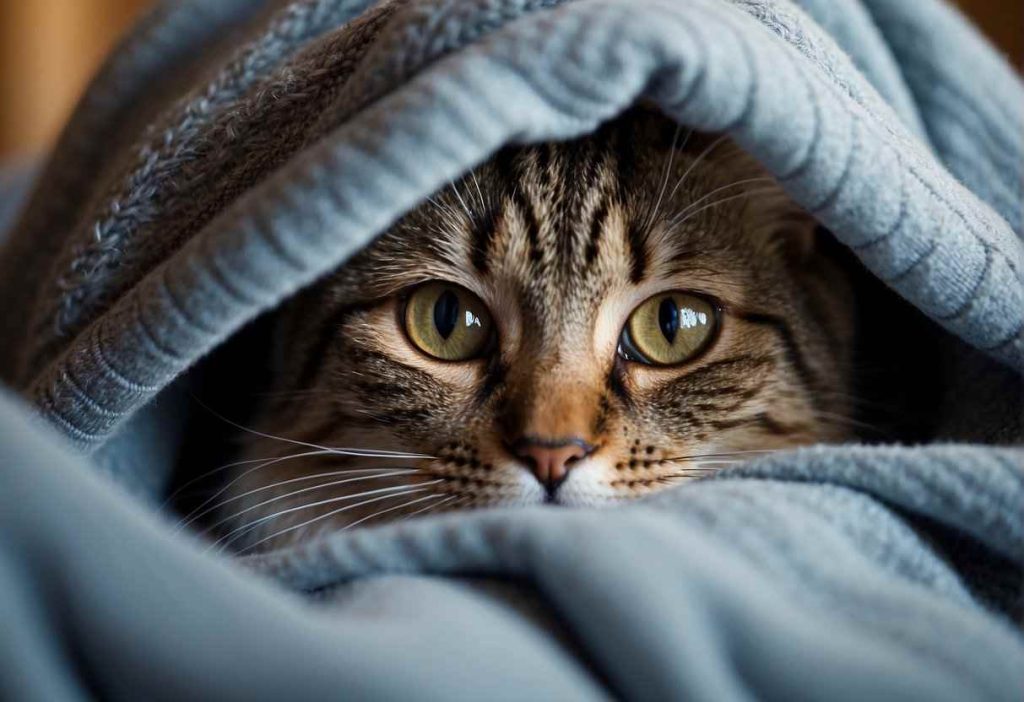
Playtime doesn’t necessarily stop when humans hit the hay.
Your little furball’s fondness for burrowing under covers can turn your bed into an amusement park, and honestly, what’s better than a bit of relaxation with a side of giggles and protection from parasites?
Enjoyable Anecdotes and Cat Quirks
Do you remember the time… when your whiskered friend disappeared, and you found them in a blanket burrito?
Oh, the suspense of lifting the duvet to find those bright eyes peeking out! Cats truly are the masters of hide and seek, aren’t they?
Here’s a quick rundown of why Cats and Covers become such a quirky tale:
- Hide-and-Seek Champions: Cats love a good hideout. It’s a game that never gets old!
- Cozy Cuddles: The snug feeling under the blankets can be a huge anxiety-reducer for pets.
- Warmth Seekers: Remember, your cat prefers a temperature range slightly above our own.
- Safety Zone: Under the covers may just be their favorite relaxation spot, away from the chaos of the world.
Using positive reinforcement with treats or an affectionate pat when they emerge can encourage a healthy balance between their undercover escapades and playtime with you.
Sure, you might worry about their breathing for a moment, but cats are pros at making a swift exit when needed—and it’s part of what makes living with them an adventure.
So, next time you catch your kitty sneaking under the sheets, remember they’re probably just finding their purr-fect hideaway for a little snooze—or perhaps prepping for their next “attack” on your unsuspecting toes.
Keep the camera ready, because these are the candid moments that cat memes are made of!
Focusing on Health and Well-being
Kittens and adult cats alike may seek the cozy shelter of blankets, but as cat owners, it’s your job to ensure their environment promotes both safety and comfort.
Under the covers, cats rely on their ability to navigate to breathable spaces. Generally, they have the smarts to find their way to the edge for air, yet it’s crucial to consider the material and thickness of your blankets.
Some fabrics could pose more difficulty for your cat to breathe if they are too heavy or not well-ventilated.
Remember, a cat’s average body temperature is a toasty 100.5 ° F to 102.5 ° F, so they usually handle being under a blanket quite well, but it’s always better to err on the side of caution.
To foster a healthy environment:
- Provide your kitty with a cat bed that offers plenty of airflow.
- If you allow them under the covers, check regularly to ensure they’re not entangled or showing signs of distress.
Mental stimulation is just as important for your cat’s well-being. A fun fact: did you know cats can make fun even under the covers, chasing their tails or playing with imaginary prey?
However, keep their play space clutter-free to avoid accidental cover traps.
Your cat’s well-being rests on the balance of their physical and mental health, which is highly connected to their surrounding environment. (7)
By taking a few mindful actions and providing a nurturing space, you’ll help ensure your purring pal stays happy and healthy, including spending time in their instincts.
After all, their nine lives are precious, and with your care, each day can be as cozy and safe as they deserve.
Quick Recap
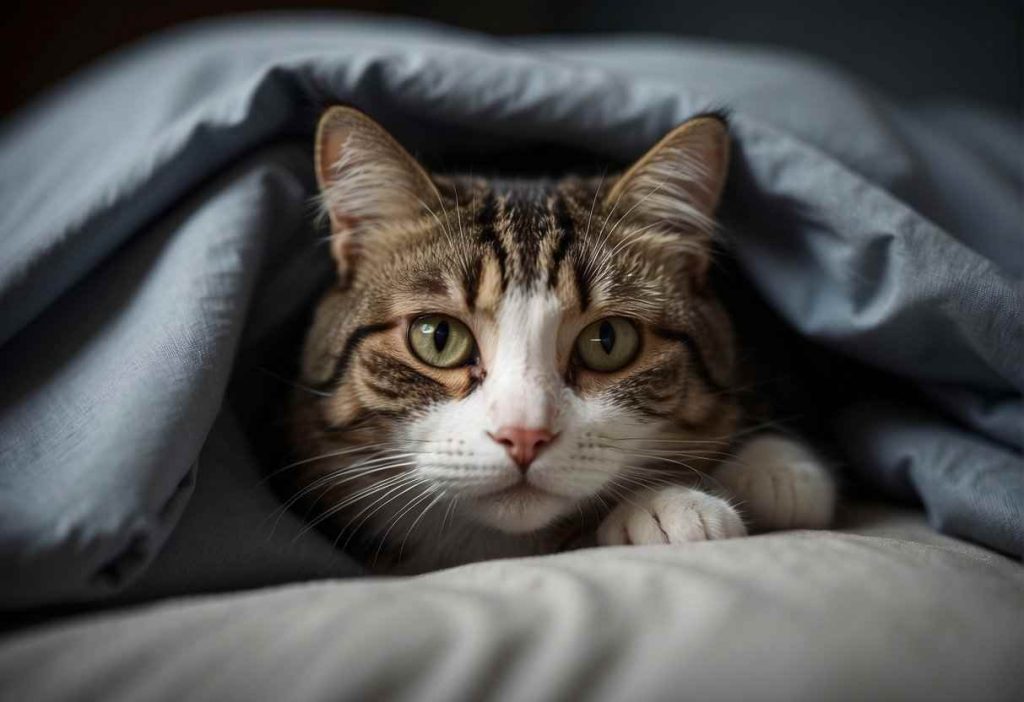
Suffocation under blankets is rare for cats. They are nimble creatures adept at navigating their surroundings.
If they were uncomfortable, they’d likely wriggle free or poke their head out for air. However, there are a few things you should keep in mind for their safety, including the type of cover fabrics used on your bed.
- Monitor for respiratory issues:
- Restlessness could indicate discomfort.
- Cats with pre-existing respiratory conditions require extra attention.
- Materials matter:
- Choose breathable fabrics to maintain good airflow.
- Avoid heavy or overly thick blankets that are harder to move.
You love your cat, and part of that love is ensuring they’re safe, even during nap time. Let’s make their sleep environment as safe as possible.
Do you have any clever tips or personal stories about your cat’s sleeping quirks? Share them! Your fun tale might just be the tip another cat owner needs.
Frequently Asked Questions
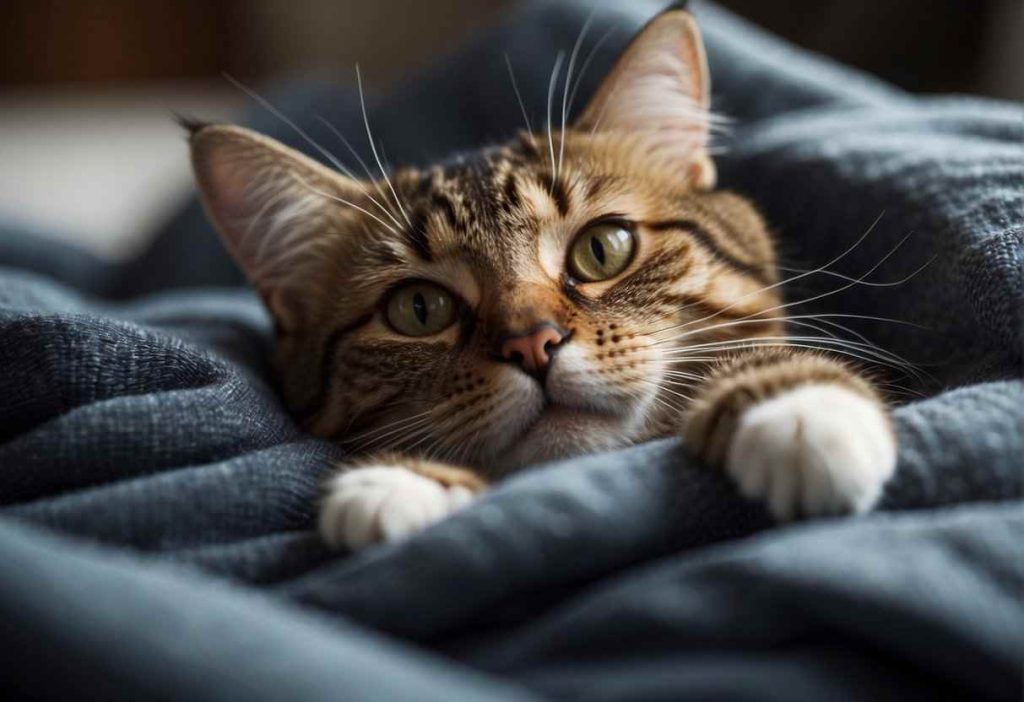
When it comes to your furry friend cozying up under the covers, you may have some concerns and queries. Let’s dig straight into the common questions cat owners have about this snug behavior.
Is it safe for my cat to sleep under the covers?
It’s usually safe for your cat to sleep under the covers as they are good at finding their way out if they need more air.
However, always ensure that the space under the blanket is ample enough for them to breathe comfortably.
Why does my cat prefer to sleep under covers?
Your kitty likely enjoys the warmth and security that blankets offer, much like a comfortable den.
It’s a spot where they can relax to their heart’s content, away from the hustle and bustle of the household.
How can I tell if my cat is comfortable sleeping under the covers?
Watch for signs of relaxation, like purring or a calm disposition when they’re nestled under the covers.
If they seem restless or struggle to find air, they may not be entirely comfortable.
What materials are safest for my cat to sleep under?
Opt for breathable materials like cotton or fleece that provide warmth without being too heavy or restricting airflow.
Thicker, less breathable fabrics might not be the best choice for extended snoozing sessions.
Can sleeping under covers affect my cat’s behavior or health?
Generally, sleeping under the covers won’t harm your cat’s health or behavior.
However, if your cat has respiratory issues, be extra cautious; a blanket might make breathing more difficult, potentially leading to stress or ill health.
How do I create a safe and comfortable sleeping environment for my cat?
Make sure their sleeping area is quiet, cozy, and free from drafts.
Providing a cat bed with a blanket that they can easily move on or off will give them the option to snuggle as they see fit, ensuring their comfort and safety.
- The Ultimate Overview to Actual Cash Gambling Establishments - July 1, 2025

